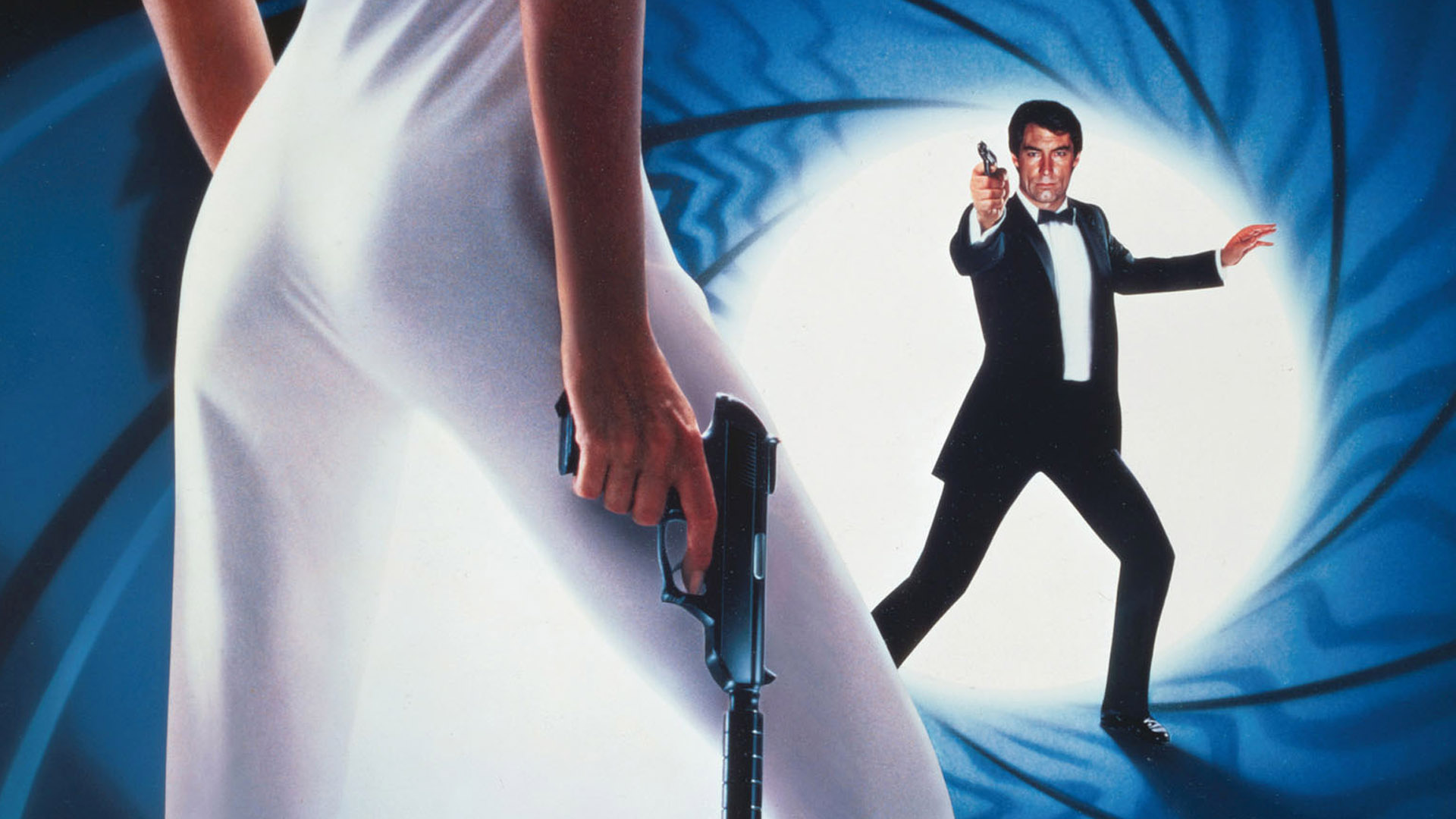The Living Daylights (1987, Dir. John Glen):
‘She was a blonde. She was the girl who carried the cello in that orchestra. Probably had her gun in the cello case. The orchestra was to cover up the shooting.’
‘Oh!’ said Captain Sender slowly. ‘I see. The girl you were keen on?’
‘That’s right.’
‘Well, I’m sorry, but I’ll have to put that in my report too. You had clear orders to exterminate Trigger.’
There came the sound of a car approaching. It pulled up somewhere below. The bell rang twice. Sender said, ‘Well, let’s get going. They’ve sent an armoured car to get us out of here.’ He paused. His eyes flicked over Bond’s shoulder, avoiding Bond’s eyes. ‘Sorry about the report. Got to do my duty, y’know. You should have killed that sniper whoever it was.’
Bond got up. He suddenly didn’t want to leave the stinking little smashed-up flat, leave the place from which, for three days, he had had this long-range one-sided romance with an unknown girl — an unknown enemy agent with much the same job in her outfit as he had in his. Poor little bitch! She would be in worse trouble now than he was! She’d certainly be court-martialed for muffing this job. Probably be kicked out of the KGB. He shrugged. At least they’d stop short of killing her — as he had himself had done.
He said wearily, ‘Okay. With any luck it’ll cost me my Double-O number. But tell Head of Station not to worry. That girl won’t do any more sniping. Probably lost her left hand. Certainly broke her nerve for that kind of work. Scared the living daylights out of her. In my book, that was enough. Let’s go.’
— Ian Fleming, “The Living Daylights”
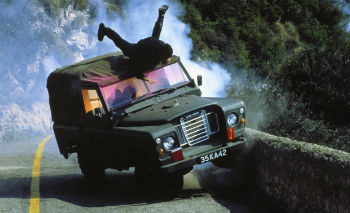 The Living Daylights is one of those back-to-basics James Bond movies (see For Your Eyes Only) which also happens to feature a new actor in the lead role. It can be seen as a creative cul de sac, or a harbinger of where the series is today. It’s arguably the best Bond movie of the ’80s, which might say more about the decade than about the quality of the movie. It has been overrated and underrated in nearly equal measure. Perhaps these mixed messages are fitting, considering the back-and-forth that went into the casting of James Bond for the film.
The Living Daylights is one of those back-to-basics James Bond movies (see For Your Eyes Only) which also happens to feature a new actor in the lead role. It can be seen as a creative cul de sac, or a harbinger of where the series is today. It’s arguably the best Bond movie of the ’80s, which might say more about the decade than about the quality of the movie. It has been overrated and underrated in nearly equal measure. Perhaps these mixed messages are fitting, considering the back-and-forth that went into the casting of James Bond for the film.
With Roger Moore’s final retirement after a wearying seven movies, producer Albert Broccoli and his stepson, executive producer Michael G. Wilson, were afforded the opportunity to wipe the slate clean. Octopussy and A View to a Kill had left any sort of reality in the rear-view mirror; the time seemed right to bring Bond back to something resembling human dimensions once again. Wilson was in favor of casting Sam Neill, coming off the heels of Reilly: Ace of Spies (watch this snippet of screen test and daydream about what might have been), but Broccoli preferred a safer option: Pierce Brosnan.
 At the time, bestowing the mantle of 007 on Brosnan seemed eminently logical — in the court of public opinion, he was practically groomed for the part, although some might have wondered how the light, frothy style he had brought to Remington Steele would transfer to the more sober approach Broccoli and Wilson had in mind for Bond. (Brosnan would later prove himself fully capable of playing a cold-blooded killer in the Cold War thriller The Fourth Protocol (1987).) A middle ground was decided upon: the screenplay of The Living Daylights would be straightforward and “generic” in tone, leaving room for the actor’s interpretation. But the execs at NBC, realizing they had a golden goose on their hands, renewed Remington Steele at the eleventh hour for another season. Reasoning that less folks would want to see Bond in the cinema when he was on the boob tube every Thursday night, Broccoli canceled the deal with Brosnan. His fall-back choice (Broccoli would later claim he was their first choice but that scheduling wasn’t conducive at the time — the Bond producers are notorious for the occasional dose of revisionist history) was an actor cut from an altogether different cloth: Timothy Dalton. Shakespearean-trained, publicity-shy, tall and brooding like every good Welshman should be, and committed to his craft, he would have no issue with portraying a serious James Bond — underline the word “serious” in heavy black marker.
At the time, bestowing the mantle of 007 on Brosnan seemed eminently logical — in the court of public opinion, he was practically groomed for the part, although some might have wondered how the light, frothy style he had brought to Remington Steele would transfer to the more sober approach Broccoli and Wilson had in mind for Bond. (Brosnan would later prove himself fully capable of playing a cold-blooded killer in the Cold War thriller The Fourth Protocol (1987).) A middle ground was decided upon: the screenplay of The Living Daylights would be straightforward and “generic” in tone, leaving room for the actor’s interpretation. But the execs at NBC, realizing they had a golden goose on their hands, renewed Remington Steele at the eleventh hour for another season. Reasoning that less folks would want to see Bond in the cinema when he was on the boob tube every Thursday night, Broccoli canceled the deal with Brosnan. His fall-back choice (Broccoli would later claim he was their first choice but that scheduling wasn’t conducive at the time — the Bond producers are notorious for the occasional dose of revisionist history) was an actor cut from an altogether different cloth: Timothy Dalton. Shakespearean-trained, publicity-shy, tall and brooding like every good Welshman should be, and committed to his craft, he would have no issue with portraying a serious James Bond — underline the word “serious” in heavy black marker.
 Dalton knew his Ian Fleming, and was eager to capture the writer’s spirit. His portrayal would refer back to the heroes of British war fiction: super-competent men who speak softly but carry a big stick. Forgoing raised eyebrows and throwaway quips for the most part, Bond would be a just-get-it-done type, susceptible to emotions like exasperation and love. Taking advantage of Dalton’s chops, scenes were modified to fit his style, such as when Bond ambushes a KGB bigwig (John Rhys-Davies) and threatens to execute him. The plot, too, would locate itself in the current geo-political climate instead of the fanciful realms of world domination. The bad guys’ scheme (juggling weapons trade with opium deals in Afghanistan) would be something right in Oliver North’s wheelhouse; Bond would have to do some honest-to-goodness investigative work for once, and extract the truth from a thicket of double-crosses. Even Bond’s love life wouldn’t be immune from societal change — with the AIDS virus invading the public consciousness, critics made much of the idea that 007 has only one love interest in the movie (they tend to forget that dame on the yacht in the pre-title sequence, but whatever). As frosting on the cake, the entire plot of Ian Fleming’s short story “The Living Daylights” would be the jumping-off point for the film — the first time Fleming material had been adopted for a Bond movie since For Your Eyes Only.
Dalton knew his Ian Fleming, and was eager to capture the writer’s spirit. His portrayal would refer back to the heroes of British war fiction: super-competent men who speak softly but carry a big stick. Forgoing raised eyebrows and throwaway quips for the most part, Bond would be a just-get-it-done type, susceptible to emotions like exasperation and love. Taking advantage of Dalton’s chops, scenes were modified to fit his style, such as when Bond ambushes a KGB bigwig (John Rhys-Davies) and threatens to execute him. The plot, too, would locate itself in the current geo-political climate instead of the fanciful realms of world domination. The bad guys’ scheme (juggling weapons trade with opium deals in Afghanistan) would be something right in Oliver North’s wheelhouse; Bond would have to do some honest-to-goodness investigative work for once, and extract the truth from a thicket of double-crosses. Even Bond’s love life wouldn’t be immune from societal change — with the AIDS virus invading the public consciousness, critics made much of the idea that 007 has only one love interest in the movie (they tend to forget that dame on the yacht in the pre-title sequence, but whatever). As frosting on the cake, the entire plot of Ian Fleming’s short story “The Living Daylights” would be the jumping-off point for the film — the first time Fleming material had been adopted for a Bond movie since For Your Eyes Only.
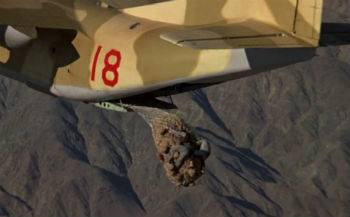 It all sounds very promising, and quite a few scenes in The Living Daylights make good on the promise. The pre-title action setpiece atop the Rock of Gibraltar, replete with skydiving stunts and trucks rocked by dynamite, gets the film off to a propulsive start. The subsequent sniper assassination sequence, lifted from the Fleming short story, captures the author’s world-weary élan (“Look my friend, I’ve got to commit a murder tonight. Not you. Me. So be a good chap and stuff it, will you?”) as well as any Bond movie has. If nothing else, it’s refreshing to see a Bond who is convincingly fit and dangerous. Dalton’s presence seems to rouse director John Glen — the film has a smidge more travelogue flair than usual, most notably in Vienna. In a homecoming of sorts, Glen even stages a romantic tryst in Prater Park’s ferris wheel, a counterpoint to the famous Orson Welles “cuckoo clock” scene in The Third Man — the first film Glen ever worked on. The Living Daylights also marks the end of some major Bond staples: the “battling armies” climax on an Afghanistan airstrip would be the last of its kind, and the film would feature John Barry’s final go-round as a composer. Rising to the challenge of backing up a new Bond, Barry weaves together a memorable score, threading three major themes (two by the Pretenders, one by a-ha) into the action.
It all sounds very promising, and quite a few scenes in The Living Daylights make good on the promise. The pre-title action setpiece atop the Rock of Gibraltar, replete with skydiving stunts and trucks rocked by dynamite, gets the film off to a propulsive start. The subsequent sniper assassination sequence, lifted from the Fleming short story, captures the author’s world-weary élan (“Look my friend, I’ve got to commit a murder tonight. Not you. Me. So be a good chap and stuff it, will you?”) as well as any Bond movie has. If nothing else, it’s refreshing to see a Bond who is convincingly fit and dangerous. Dalton’s presence seems to rouse director John Glen — the film has a smidge more travelogue flair than usual, most notably in Vienna. In a homecoming of sorts, Glen even stages a romantic tryst in Prater Park’s ferris wheel, a counterpoint to the famous Orson Welles “cuckoo clock” scene in The Third Man — the first film Glen ever worked on. The Living Daylights also marks the end of some major Bond staples: the “battling armies” climax on an Afghanistan airstrip would be the last of its kind, and the film would feature John Barry’s final go-round as a composer. Rising to the challenge of backing up a new Bond, Barry weaves together a memorable score, threading three major themes (two by the Pretenders, one by a-ha) into the action.
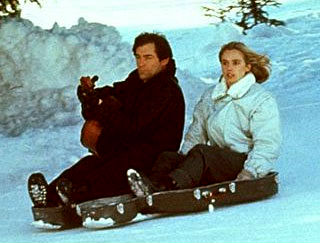 For all its decent moments, though, The Living Daylights is hamstrung by compromise. Dalton and slivers of the script attempt to steer the film towards a true representation of Fleming, but the Bond machine still has one foot firmly planted in the Moore era. Thus we have Bond and Kara fleeing the Czech military by, ahem, slaloming away on her cello case. This only comes after Bond’s Aston Martin splits a car in two with a laser, and rockets around on an ice lake like the Batmobile, Dalton muttering half-hearted puns the whole way. Moore would have made these bits palatable by sending them up; Dalton can only grimace, his stern determination rendering the sequence even more awkward. More damaging is the lack of a high-class villain. Jeroen Krabbé is slippery as a renegade Russian general and Joe Don Baker supplies a heavy dose of good-ol’-boy braggadocio as Brad Whitaker, an arms dealer with a predilection for military history and dioramas with real guns; neither of them have the quirks or stature of a classic antagonist. All Bond movies face the challenge of maintaining a very delicate balance — get too goofy and all tension drains out of the movie, downscale things too much and you lose the je ne sais quoi that separates Bond from the competition. The Living Daylights holds together as a story better than most entries in the series, but at the expense of pizzazz. Do we really want to see Bond and Kara mired in Afghanistan in the third act, forced to buddy up with the Mujahideen rebels (who knew that in less than two decades, these folks would turn out to be so evil)? The movie wants to be taken seriously as a spy thriller, which is a problem when the spying isn’t all that thrilling.
For all its decent moments, though, The Living Daylights is hamstrung by compromise. Dalton and slivers of the script attempt to steer the film towards a true representation of Fleming, but the Bond machine still has one foot firmly planted in the Moore era. Thus we have Bond and Kara fleeing the Czech military by, ahem, slaloming away on her cello case. This only comes after Bond’s Aston Martin splits a car in two with a laser, and rockets around on an ice lake like the Batmobile, Dalton muttering half-hearted puns the whole way. Moore would have made these bits palatable by sending them up; Dalton can only grimace, his stern determination rendering the sequence even more awkward. More damaging is the lack of a high-class villain. Jeroen Krabbé is slippery as a renegade Russian general and Joe Don Baker supplies a heavy dose of good-ol’-boy braggadocio as Brad Whitaker, an arms dealer with a predilection for military history and dioramas with real guns; neither of them have the quirks or stature of a classic antagonist. All Bond movies face the challenge of maintaining a very delicate balance — get too goofy and all tension drains out of the movie, downscale things too much and you lose the je ne sais quoi that separates Bond from the competition. The Living Daylights holds together as a story better than most entries in the series, but at the expense of pizzazz. Do we really want to see Bond and Kara mired in Afghanistan in the third act, forced to buddy up with the Mujahideen rebels (who knew that in less than two decades, these folks would turn out to be so evil)? The movie wants to be taken seriously as a spy thriller, which is a problem when the spying isn’t all that thrilling.
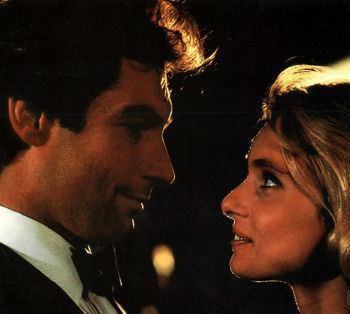 “The most dangerous Bond. Ever,” promised the posters for The Living Daylights, and it’s an open debate whether that claim is true. The film doesn’t up its game high enough to rank among the very best of the series, but what of Bond himself? Is it possible for a Bond actor to be both overrated and underrated? That’s the conundrum we face with Dalton. The general public never took well to him, no doubt partially due to sympathy for Brosnan. It’s too bad the prevailing perception of Dalton is that he was a grumpy bore in the role, given the professionalism and credibility he restored to the character. On the other hand, a sizable contingent of Bond fans have trumpeted his interpretation as being the closest to Fleming’s creation, and grumble about Daniel Craig’s acclaimed take — why should Craig get all the credit when it was Dalton who pioneered the more serious version of Bond? Of course, this all presupposes that Fleming’s Bond was serious to begin with. Sure the literary 007 could sometimes be a bit of a prig, and Dalton, saturnine as he is, has that portion of Bond’s personality down cold. But Fleming was always cognizant of the absurdity at the core of his hero — the least secret agent in the world, Bond was a man in the shadows who couldn’t help standing out because of his enormous appetites. Dalton is too tightly wound, too self-conscious, to convincingly portray the animal hiding beneath the gentlemanly armor. Though his Bond might resemble Bond in surface appearance, he can’t quite capture the irreducible mystery at the character’s heart. Certainly his romance with Kara Milovy (Maryam D’abo, overdoing the naiveté) doesn’t bring us any closer to that mystery — we’re meant to swoon a bit when Bond and the young cellist get swept away with each other, but would Fleming’s Bond (or any Bond for that matter) be as teeth-gratingly sincere as he is here? “I’ve been such a fool,” Kara confesses at one point. “We both have,” Bond agrees, with nary a hint of irony.
“The most dangerous Bond. Ever,” promised the posters for The Living Daylights, and it’s an open debate whether that claim is true. The film doesn’t up its game high enough to rank among the very best of the series, but what of Bond himself? Is it possible for a Bond actor to be both overrated and underrated? That’s the conundrum we face with Dalton. The general public never took well to him, no doubt partially due to sympathy for Brosnan. It’s too bad the prevailing perception of Dalton is that he was a grumpy bore in the role, given the professionalism and credibility he restored to the character. On the other hand, a sizable contingent of Bond fans have trumpeted his interpretation as being the closest to Fleming’s creation, and grumble about Daniel Craig’s acclaimed take — why should Craig get all the credit when it was Dalton who pioneered the more serious version of Bond? Of course, this all presupposes that Fleming’s Bond was serious to begin with. Sure the literary 007 could sometimes be a bit of a prig, and Dalton, saturnine as he is, has that portion of Bond’s personality down cold. But Fleming was always cognizant of the absurdity at the core of his hero — the least secret agent in the world, Bond was a man in the shadows who couldn’t help standing out because of his enormous appetites. Dalton is too tightly wound, too self-conscious, to convincingly portray the animal hiding beneath the gentlemanly armor. Though his Bond might resemble Bond in surface appearance, he can’t quite capture the irreducible mystery at the character’s heart. Certainly his romance with Kara Milovy (Maryam D’abo, overdoing the naiveté) doesn’t bring us any closer to that mystery — we’re meant to swoon a bit when Bond and the young cellist get swept away with each other, but would Fleming’s Bond (or any Bond for that matter) be as teeth-gratingly sincere as he is here? “I’ve been such a fool,” Kara confesses at one point. “We both have,” Bond agrees, with nary a hint of irony.
Both critically and commercially, The Living Daylights was a step up from A View to a Kill, but it wasn’t enough of a blockbuster to assure Broccoli and Wilson that they were on the right track. More extreme measures were needed; soon things would get very personal with Bond. In the meantime, Daylights leaves us with a complicated legacy. The film is a hedged bet: Although it would be the last classically styled, classically produced Bond film, and the final 007 opus which presented our hero as simply a man on a mission, it also wants to impress us with the newfound gravity in Bond’s character. There’s a fine line between gravity and dullness, though, and as admirable as the movie often is, it feels more like a sidestep than a bold stride forward.

